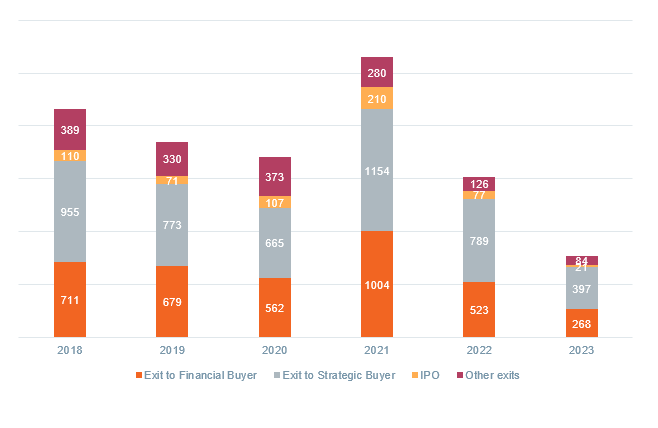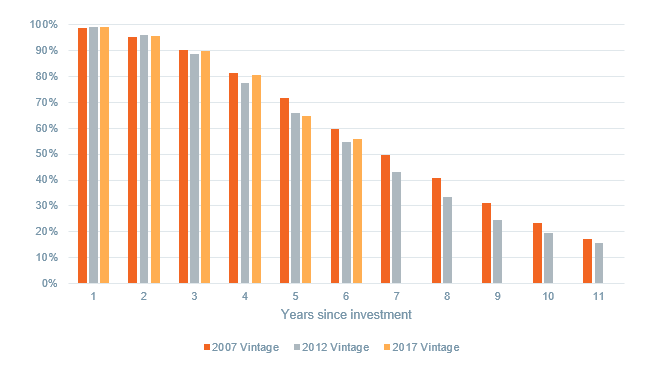 Equal Housing Lender. Bank NMLS #381076. Member FDIC.
Equal Housing Lender. Bank NMLS #381076. Member FDIC.
 Equal Housing Lender. Bank NMLS #381076. Member FDIC.
Equal Housing Lender. Bank NMLS #381076. Member FDIC.
Private equity had a roaring 2021, boasting record-setting fundraising and a tidal wave of deal activity as investors quickly bounced back from pandemic-driven nervousness. The number of private equity deals in 2021 jumped by 87% in the U.S., with total transaction value 2.5x 2020 values as the combined firehose of M&A sales, IPOs, and SPAC mergers made liquidity easy to come by with higher demand pushing prices higher.
Figure 1: U.S. private equity comes down from pandemic-era highs, with exits seeing the most dramatic decrease in volume and value
U.S. PE Deal Activity

Source: Pitchbook-Venture Capital, Private Equity, and M&A Market Database. 2023 data through Sept 30. Deal count for 2022 and 2023 YTD is estimated.
This Goldilocks environment of low rates, investor demand, strong growth, and robust valuations was fleeting, however, as the onset of inflation, rapid rate increases, and a cloudy macro outlook soured the party. While deal count remains roughly in line with historic averages, aggregate transaction value has dropped and much of the activity is in recapitalizations, restructurings, follow-ons, and secondary sales rather than full company sales/exits. Pricing has come down and capital availability has dried up. Quarterly exits began their descent in number and value at the end of 2021, stalled dramatically through 2022, and continued to march downward through the end of 3Q 2023. The exit-to-investment ratio (a comparison for number of exits versus number of investments, where a ratio of 1 would indicate an equal number of exits and investments) hit a historically low rate by the end of 3Q 2023, standing at 0.37x, versus 0.48x in 2021 and 0.41x in 2022.[1]
Transaction volumes were down across exit types. A disconnect between buyers and sellers on expected pricing and difficulty obtaining financing are both contributing to market tightness.
Figure 2: Tight market conditions limited compelling exit opportunities.
Global PE exists by type

Source: Prequin, S&P Global. 2023 data through June 30. “Other exits” includes bankruptcy/write-offs, private placements/follow-ons, sale to management, and unspecified exits.
Valuations
With deal activity at an all-time high in 2021, valuations were pushed higher by the sheer level of capital being deployed. Median private equity enterprise value (EV)/revenue multiples jumped nearly 32% year-over-year from 2020 to 2021, peaking at 2.5x.[2] For certain private equity sectors, such as fast-growing technology companies, the purchase multiples were far higher. EV/revenue multiples and EV/EBITDA (earnings before interest, taxes, depreciation, and amortization—another common multiple for firms where revenue may be an inaccurate representation of the business’ performance) have both since declined from highs, though the limited transaction volume may lead to distortions when looking at industry averages.
The valuation/pricing environment today can be described as a disconnect or stalemate with company owners often anchored to prices that bankers suggested were achievable in 2021, while buyers are looking to pay significantly lower prices. As a result, many companies that do not have to raise money or exit in what they perceive as an unfavorable environment are opting to hold back until conditions improve.
Financing
While deal activity has slowed across the board, buyout transactions have been particularly hard hit due to their greater dependency on leverage (the use of borrowed money), less attractive in a higher rate environment. Within buyouts, larger transactions have slowed more than smaller transactions due to the dependence on bank-led financings as banks have slowed their corporate lending and tightened underwriting standards. The number of completed platform deals, large buyouts that frequently form the backbone of a private equity portfolio, has fallen over 40% through the third quarter as loan-to-value (LTV) ratios, or the amount of debt used as a percentage of the total deal, plunged to just below 44% in 3Q from a 10-year average of 55%.[3]
Increased financing costs directly impacts the purchasing power of upmarket players who are key buyers of portfolio companies. Certain buyouts may look less compelling from a returns perspective with less and/or more costly leverage. In the case of sponsor-to-sponsor sales, the reality of coughing up additional capital at purchase leaves less space in funds for additional deals, impacting portfolio diversification. With fewer interested parties, platform leveraged buyouts have declined to below 40% of total private equity deal value, from nearly 60% in mid-2021.[4]
Near-term exit opportunities
While the last year and a half has been challenging, it represents a small fraction of the average lifespan of a private equity fund, which typically lasts 10+ years. In fact, across multiple market environments, it’s typical that between 50%–60% of portfolio companies are still held by their private equity sponsor at five years post purchase.
Figure 3: Share of U.S. PE Buyout Companies Still Held

Source: Pitchbook-Venture Capital, Private Equity, and M&A Market Database. As of December 2022.
While it has been a difficult 18 months, there are reasons to believe there may be a light at the end of the tunnel. The IPO market has notably loosened up during late summer, with more companies going public, filing their pre-IPO S-1s, or exploring a public market exit. Exits to strategic buyers (often corporates) have faltered on a year-over-year basis, but companies with cash on hand (or the ability to issue debt) and an appetite for innovative new technologies or products continue to offer exit opportunities in tighter markets. Exits to other private equity firms (sponsor-to-sponsor deals), a hallmark exit strategy during normalized environments, has been the slowest to pick back up, remaining at lows unseen since the depths of the pandemic. However, the need to deploy the massive amount of capital many PE firms raised over the prior two years, in addition to the demands from investors to see capital from older funds returned, makes the go-forward environment much riper for sponsor-to-sponsor deals.
Core narrative
While it can be challenging to take a step back amid negative headlines, it is important to remember the potential advantages of including private equity in a well-diversified portfolio. Private markets exposure, inclusive of private equity, has historically reduced volatility and increased returns of a broader portfolio. Private equity can provide access to less efficient segments of the market and the illiquid nature of private equity investing allows for a long-term approach to improving businesses, backed by the often-significant capital resources of the sponsor firm.
Further, near-term headwinds are not necessarily indicative of poor longer-term results. Private equity funds have historically delivered even stronger relative performance in challenging market conditions, with multiple levers to pull to protect and improve value at a time when non-sponsored companies may be struggling.[5] Extended hold periods may reduce near-term distributions but could provide opportunities for sponsors to upgrade their holdings.
Wilmington Trust has always advised vintage year diversity in building out a private equity portfolio. While more recent funds deployed capital during the frothy market, they are early in their fund lives and still have capital to invest. Earlier vintages with more mature portfolios still have a comfortable window to continue to work prior to their term limit, reducing the chances of forced selling at depressed valuations. These funds were also well-positioned to take advantage of the increased deal demand in prior years to return capital and are readying the remainder of their portfolios for exit as conditions normalize. A well-diversified private equity portfolio can provide some level of comfort to investors worried about the current buyout environment. We believe that private equity funds have ample flexibility to wait out unfavorable conditions.
[1] Pitchbook-Venture Capital, Private Equity, and M&A Market Database
[2] Pitchbook-Venture Capital, Private Equity, and M&A Market Database
[3] Pitchbook-Venture Capital, Private Equity, and M&A Market Database
[4] Pitchbook-Venture Capital, Private Equity, and M&A Market Database
[5] Nick Veronis and Tatiana Esipovich, “Private Equity Offers Resilience in a Downturn,” iDirect Private Market Fund (iDPE), March 16, 2020.
Definitions
A follow-on is a subsequent investment made by an investor in a company they previously invested in, generally at a later stage in the fundraising cycle in comparison to the initial investment.
An S-1 is an SEC filing used by companies planning to go public to register their securities with the U.S. Securities and Exchange Commission (SEC).
Vintage year in the private equity and venture capital industries refers to the year in which a fund began making investments or, more specifically, the date in which capital was deployed to a particular company or project.
Facts and views presented in this report have not been reviewed by, and may not reflect information known to, professionals in other business areas of Wilmington Trust or M&T Bank who may provide or seek to provide financial services to entities referred to in this report. M&T Bank and Wilmington Trust have established information barriers between their various business groups. As a result, M&T Bank and Wilmington Trust do not disclose certain client relationships with, or compensation received from, such entities in their reports.
The information on Wilmington Wire has been obtained from sources believed to be reliable, but its accuracy and completeness are not guaranteed. The opinions, estimates, and projections constitute the judgment of Wilmington Trust and are subject to change without notice. This commentary is for informational purposes only and is not intended as an offer or solicitation for the sale of any financial product or service or a recommendation or determination that any investment strategy is suitable for a specific investor. Investors should seek financial advice regarding the suitability of any investment strategy based on the investor’s objectives, financial situation, and particular needs. Diversification does not ensure a profit or guarantee against a loss. There is no assurance that any investment strategy will succeed.
Past performance cannot guarantee future results. Investing involves risk and you may incur a profit or a loss.
Indexes are not available for direct investment. Investment in a security or strategy designed to replicate the performance of an index will incur expenses such as management fees and transaction costs which will reduce returns.
Reference to the company names mentioned in this blog is merely for explaining the market view and should not be construed as investment advice or investment recommendations of those companies. Third party trademarks and brands are the property of their respective owners.
The gold industry can be significantly affected by international monetary and political developments as well as supply and demand for gold and operational costs associated with mining.
Stay Informed
Subscribe
Ideas, analysis, and perspectives to help you make your next move with confidence.
What can we help you with today